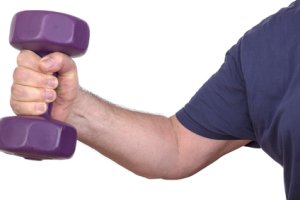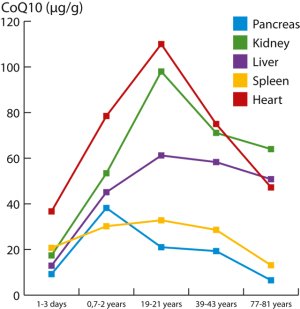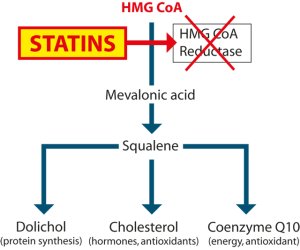Coenzyme Q10 as a determining factor of muscle strength and ageing processes
 Ageing processes are associated with loss of muscle mass and impaired physical performance, both of which tend to lower quality of life. It is commonly known that coenzyme Q10 plays a significant role in cellular energy turnover and protects against oxidative stress. Now, two independent cohort studies even show a relation between the body’s Q10 status and muscle strength. Earlier research even suggests that Q10 supplements may help older people develop more youthful muscle fibers. Individuals who take cholesterol-lowering statins are advised to take Q10 supplements.
Ageing processes are associated with loss of muscle mass and impaired physical performance, both of which tend to lower quality of life. It is commonly known that coenzyme Q10 plays a significant role in cellular energy turnover and protects against oxidative stress. Now, two independent cohort studies even show a relation between the body’s Q10 status and muscle strength. Earlier research even suggests that Q10 supplements may help older people develop more youthful muscle fibers. Individuals who take cholesterol-lowering statins are advised to take Q10 supplements.
As we grow older, our muscle mass decreases. After the age of 50, we generally lose around 0.5 to 1 percent of our muscle mass every year. The loss accelerates after we are past 65-70 years of age. This loss of muscle mass is a result of our protein breakdown overshadowing our protein build-up. It also explains why many people tend to develop flat bottoms and thin extremities (fingers and toes). It is a result of their muscles decreasing in size. There is even evidence that older people tend to consume less protein than recommended, which only makes the problem worse.
Loss of muscle mass is not necessarily a problem, yet it tends to make older people more feeble. Also, reduced physical performance is often associated with impaired quality of life, cardiovascular disease, and premature death in worst case.
Age-related loss of muscle mass is even linked to damage to the muscle-building proteins and at reduction in the number of muscle fibers. This is where coenzyme Q10 appears to have several important roles.
Q10’s important roles in energy turnover, health, and muscles
Q10 is a coenzyme that works around the clock inside the mitochondria, which are the powerhouses of our cells. Q10, helped by oxygen, converts fat, carbohydrates and protein into ATP (adenosine triphosphate) – energy stored chemically in molecular form. Muscle tissue, including the heart, is particularly dependent on energy and therefore contains more mitochondria than other body tissues. Q10 also functions as an antioxidant that protects the cells against oxidative stress caused by free radicals.
Q10 even plays a role in activating genes and proteins. Our primary Q10 source is the body’s endogenous synthesis of the substance. However, from the age of around 20 years, the body’s Q10 production decreases. This reduction becomes particularly noticeable around the age of 40-50, where many people feel less vital. Cholesterol-lowering drugs also deplete Q10 levels in the body, because they block the synthesis of Q10 in the liver.
The different forms of Q10
There are two main forms of Q10, ubiquinone and ubiquinol. Ubiquinol (and supplements containing this form of Q10) is often referred to as “active Q10”, but this term is misleading, as both forms of Q10 are active, each in their own way.
Ubiquinone is the oxidized form of Q10 that is particularly important for the energy turnover in the mitochondria. Ubiquinone is yellowish and is primarily found inside the cells.
Ubiquinol is the non-oxidized form that mainly functions as an antioxidant. Ubiquinol is milky white and is primarily found in the lymphatic fluids and the blood where it protects against atherosclerosis.
The fascinating interaction
Helped by enzyme processes where selenium also plays a crucial role, ubiquinone and ubiquinol are continuously converted from one form to the other and vice versa, depending on which kind of Q10 the body needs for specific purposes. It therefore makes no difference what type of Q10 you take as a supplement. What matters is that we can make Q10 and absorb the substance from high-quality supplements. The body is then able to convert it into the form that it needs.
Low Q10 and cholesterol levels indicate an increased risk of impaired muscle strength
The aim of the two above mentioned cohort studies was to measure grip strength and compare with Q10 status, sex, age, and BMI. Grip strength is a convenient and effective way to measure a person’s muscle strength. Furthermore, the scientists behind the studies linked impaired grip strength to an increased risk of cardiovascular disease at a level comparable to hypertension. This serves to show how important our muscles are for our general health.
Using a peak flow meter, the researchers also measured the study participants’ peak expiratory flow (maximum forced exhalation), which is controlled by muscles in the airways.
A total of 1,301 people aged 20-85 years (with an average age of 52.6 years) participated in the two cohort studies. The participants’ Q10 levels and cholesterol levels were measured. This is because cholesterol is the important vehicle that carries Q10 (in the form of ubiquinol) through the blood. Because ubiquinol is a powerful antioxidant, it protects cholesterol against oxidation, which is the main cause of atherosclerosis.
The studies showed that low levels of Q10 and cholesterol may be an indicator of impaired grip strength and an increased risk of muscle mass loss.
Overweight in itself was linked to reduced Q10 levels. On other hand, physical activity tended to increase levels of Q10 in the blood and muscles, even among older people. The increased amount of Q10 is not related to muscle function alone but also the body’s defense against oxidative stress and, subsequently, a reduced risk of atherosclerosis and cardiovascular disease.
Graph showing Q10 levels in heart muscle tissue at different stages of life
|
Can Q10 supplements protect mitochondria and lower the age-related loss of muscle tissue?
There is evidence to suggest this. Researchers at Columbia University have found in earlier studies that loss of muscle mass is a result of calcium leaking from protein chains in the muscles. This initiates a series of processes that prevent muscle contraction. The scientists also found that the mitochondria play a role in cellular calcium signaling. Hence, if mitochondrial function is impaired, it may have a negative effect on muscles.
In any case, the oxidative damage in mitochondrial DNA in muscle tissue increases, as we grow older. Mitochondrial DNA is responsible for coding the important muscle-building proteins. When this DNA is damaged, the proteins are no longer formed. Consequently, damaged mitochondrial DNA is linked to loss of muscle fibers and atrophy (loss of tissue).
A study of 14 men aged 57 years and older showed that those who took supplements of Q10 got more youthful muscle fibers and muscle mass. This, presumably, was a result of Q10 counteracting oxidative damage to mitochondrial DNA in muscle cells. Of course, the effect is enhanced if a person is physically active and uses his muscles.
Cholesterol-lowering medicine lowers the body’s endogenous Q10 production
Many people, especially older individuals, take cholesterol-lowering medicine (statins). According to the two cohort studies described above, statins may be able to promote age-related loss of muscle mass.
In any case, the use of statins is linked to side effects. They occur because both cholesterol and Q10 are synthesized from an enzyme called HMG-CoA. Because statins work by blocking this enzyme, they also inhibit the synthesis of Q10.
This explains, biochemically, the side effects of statins, which typically include symptoms such as muscle pain, fatigue, and difficulty breathing because the cells lack energy.
Statins should therefore be combined with 100 mg of Q10 daily in order to reduce the side effects.
Curve showing how statins block Q10
|
Always choose a Q10 supplement that the body can absorb and utilize
Q10 is a lipid-soluble molecule, and the Q10 molecules in supplements are therefore always lipid-soluble. Q10 in various types of raw materials and supplements occur in a crystalized form that we humans cannot absorb and utilize because the crystals are unable to pass through the intestinal membrane and enter the bloodstream. In order for these crystals to dissolve, a special oil and heating technique is required. This treatment enables the crystals to dissolve, leaving each Q10 molecule free to pass through the intestinal wall.
It is always advisable to choose a Q10 supplement that can document its quality and bioavailability, as this is the only way to know for sure that the Q10 effectively reaches the mitochondria of the cells.
Why most studies are conducted using ubiquinone
The lion’s share of scientific research is conducted with Q10 in the form of ubiquinone, which is less expensive to manufacture and more stable. Ubiquinol oxidizes far more easily and is therefore difficult to contain in its ubiquinol form inside a capsule. Because of its instability, ubiquinol easily converts into ubiquinone. If that happens there is not much point in taking this form of Q10. As mentioned before, ubiquinol is milky white, while ubiquinone is yellowish. If you want to check that you are getting what you pay for, try poking a hole in a capsule and squeezing out its content for on-the-spot proof
Remember enough protein for your muscles
Protein is the building blocks of your muscles. The officially recommended daily protein intake is 0,8 grams for each kilo of body weight, but scientists have started stepping up the recommendations for older people in recent years. Now, they recommend that older people get 1 – 1.5 grams of protein to help them preserve healthy muscles. Older people who suffer from serious diseases or show signs of severe undernourishment may need 2 grams of protein.
The loss of muscle mass often results in undesirable weight loss, but the Health, Aging, and Body Composition study has shown that older people with the greatest protein intake lost 40% less weight than the quintile that consumed the fewest calories during a three-year period.
References:
Fischer Alexandra et al. Coenzyme Q10, Status as a Determinant of Muscular Strength in Two Independent Cohorts. PLoS One 2016
https://www.ncbi.nlm.nih.gov/pmc/articles/PMC5132250/
Allen, H. Pak et al. Accumulation of mitochondrial DNA deletion mutations in aged muscle fibers: evidence for a casual role in muscle fiber loss. The Journals of gerontology. Series A. Biological sciences and medical science march 2007.
Francesco Landi et al. Protein Intake and Muscle Health in Old Age: From Biological Plausibility to Clinical Evidence. Nutrients 2016
Linnane et al. Cellular redox activity of coenzyme Q10: effect of coQ10 supplementation on human skeletal muscle. Free Rad Res 2002
https://en.wikipedia.org/wiki/Sarcopenia
https://www.kost.dk/sites/default/files/uploads/public/underernaering_publikationsmallpdf.com.pdf
Pernille Lund. Q10 – fra helsekost til epokegørende medicin. Ny Videnskab 2014
Search for more information...
- Created on .










